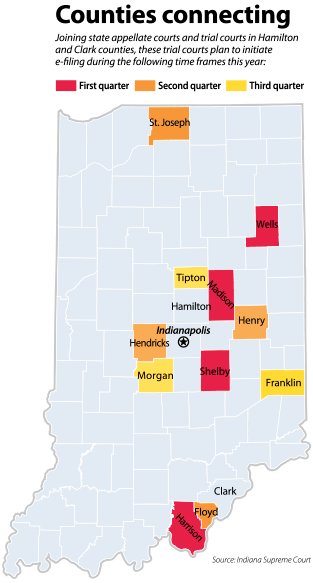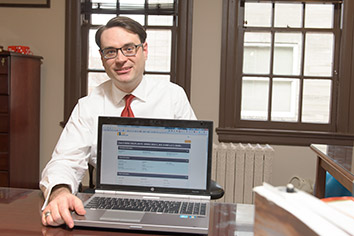Subscriber Benefit
As a subscriber you can listen to articles at work, in the car, or while you work out. Subscribe NowWhat could be easier than filing court documents from your desktop or tablet with automatic service and immediate filing confirmation? If you can see the courthouse from your office, it may just seem easier to do things the old way — dashing to the clerk’s office or having a runner do the same.
That seems to be true in some cases, at least for now.
“Sometimes we find it easier to just go up and file it because we’re right here, a block or two off the square,” said Alicia Adcock of the Noblesville firm Boje Benner Becker Markovich & Hixson LLP. “It’s probably force of habit.”
Like other practitioners, Adcock is adapting to electronic filing in the state courts, which kicked off last July with the Hamilton County pilot program and expanded to Clark County in January. By year’s end, another 11 counties are scheduled to begin offering e-filing, with a goal of service in all counties by the end of 2018.
Adcock has used the state-provided e-filing system and sees the long-term benefits. But because it’s not mandatory to file electronically — and in some cases it isn’t currently practical — she’s picking and choosing when to e-file.
So far, she likes the system. There are glitches that pop up, but they seem to get worked out quickly.
“I think that there will be a huge time savings for everyone” once electronic filing becomes mandatory, she said. “People are slowly catching on to doing e-filing.”
Indiana’s appellate courts switched to e-filing last year, and Plews Shadley Racher & Braun LLP associate Josh Tatum couldn’t be happier.
“I found it to be very intuitive and user-friendly. I expect I will file electronically on everything I can,” said Tatum, whose practice mostly involves state court appellate litigation. “You rarely get something done by 4:30, and there’s more reassurance when you have an instant email saying a filing has gone through than a rotunda filing stamp.”
Tatum is using the free state-provided Tyler Technologies e-filing system, but he expects to sample some of the systems offered by approved private vendors when more choices become available. He’s not sure whether he’d opt for a private vendor, though, because he said the state-provided software meets his needs.
So far, state courts have authorized two private vendors — Green Filing and Doxpop. More vendors are expected to be approved and offer various fee-based services with enhanced options such as scheduling, billing and case management features. Information about the state-sponsored e-filing service and those offered by vendors is available at www.courts.in.gov/efile.
Adcock has not initiated cases electronically, but she has filed motions in cases where opposing counsel has consented to accept service via e-filing. That’s a requirement lawyers must consent to on a case-by-case basis.
 Hughes
HughesMany lawyers in Hamilton County appear to be following Adcock’s lead. Hamilton Superior Judge William Hughes, who’s coordinating the county’s e-filing pilot program, said data in weekly reports on the pilot project show few lawyers are initiating cases electronically. That’s likely because paper notice of service is still required when suits are filed. Most attorneys choose to file suits as they always have, because even if they initiated a case electronically, they would still have to manually send certified mail or use a sheriff’s deputy or process server for notice.
Hughes said a rule change is in the works that would lift the requirement of initial paper service, which likely would encourage attorneys to initiate more cases electronically.
“On our part, there’s a very good reason we don’t want that to continue,” Hughes said of initial paper filings. “It makes the clerk and the court have to do all the data entry to create a case.” That duplication also increases the potential for mistakes.
“We’d like to get the problem rectified in a way that’s very comfortable for attorneys and very comfortable for us,” he said. “We think we can get there, it’s just a long process.”
Hamilton County’s trial courts digitize all filings, Hughes said, so getting those cases electronically filed from the start will save time for lawyers and court and clerk staffs.
“We’ve gotten down to where I may handle, other than things filed in court during a hearing or guilty pleas, two to three paper requests per week versus two to three per hour,” Hughes said. “It’s becoming such that dealing with paper is the problem, not dealing with digital.”
Hughes said the courts in Hamilton County are seeing evidence that lawyers are beginning to embrace e-filing when it’s a time-saving option.
 “We are finding an increasing number of filings occurring primarily in existing cases or in sub-filing categories,” he said. Adcock finds it advantageous to file electronically in cases where opposing counsel has agreed to accept service notice via e-filing. But she said there aren’t many cases in her experience in which both parties agree to electronic service.
“We are finding an increasing number of filings occurring primarily in existing cases or in sub-filing categories,” he said. Adcock finds it advantageous to file electronically in cases where opposing counsel has agreed to accept service notice via e-filing. But she said there aren’t many cases in her experience in which both parties agree to electronic service.
Teresa Anne Griffin, a partner whose practice focuses on family law at Faegre Baker Daniels LLP in Indianapolis, has filed Hamilton County cases electronically and likes the ease and convenience. Ordinarily, the same documents would either have to be couriered or mailed to the Noblesville courthouse about 20 miles away.
“We’ve almost got real-time filing,” Griffin said. “It’s nice in that sense. If a client feels an urgent need to file something right away, you can file it right away and serve it right away.”
Griffin and Adcock said they’re looking forward to the day when all the state’s counties have adopted e-filing. “It will clear up a lot of the service issues,” Adcock said.
Tatum said in cases where opposing counsel accepts e-filing notice, the time savings in copying, printing and preparing paper service can be dramatic — sometimes an hour or more per service. He said he also likes the assurance he gets knowing how a filing looks when he submits it electronically.
“My impression is all the state appellate judges are reading on screens, so if it’s on paper, they’re just going to scan it in and read it on a screen anyway,” he said.
Griffin said lawyers should be getting used to e-filing, because a time will come when going to the courthouse might not be an option.
“It might be a hard habit to break, but ultimately e-filing is going to happen everywhere,” she said.•
Please enable JavaScript to view this content.

